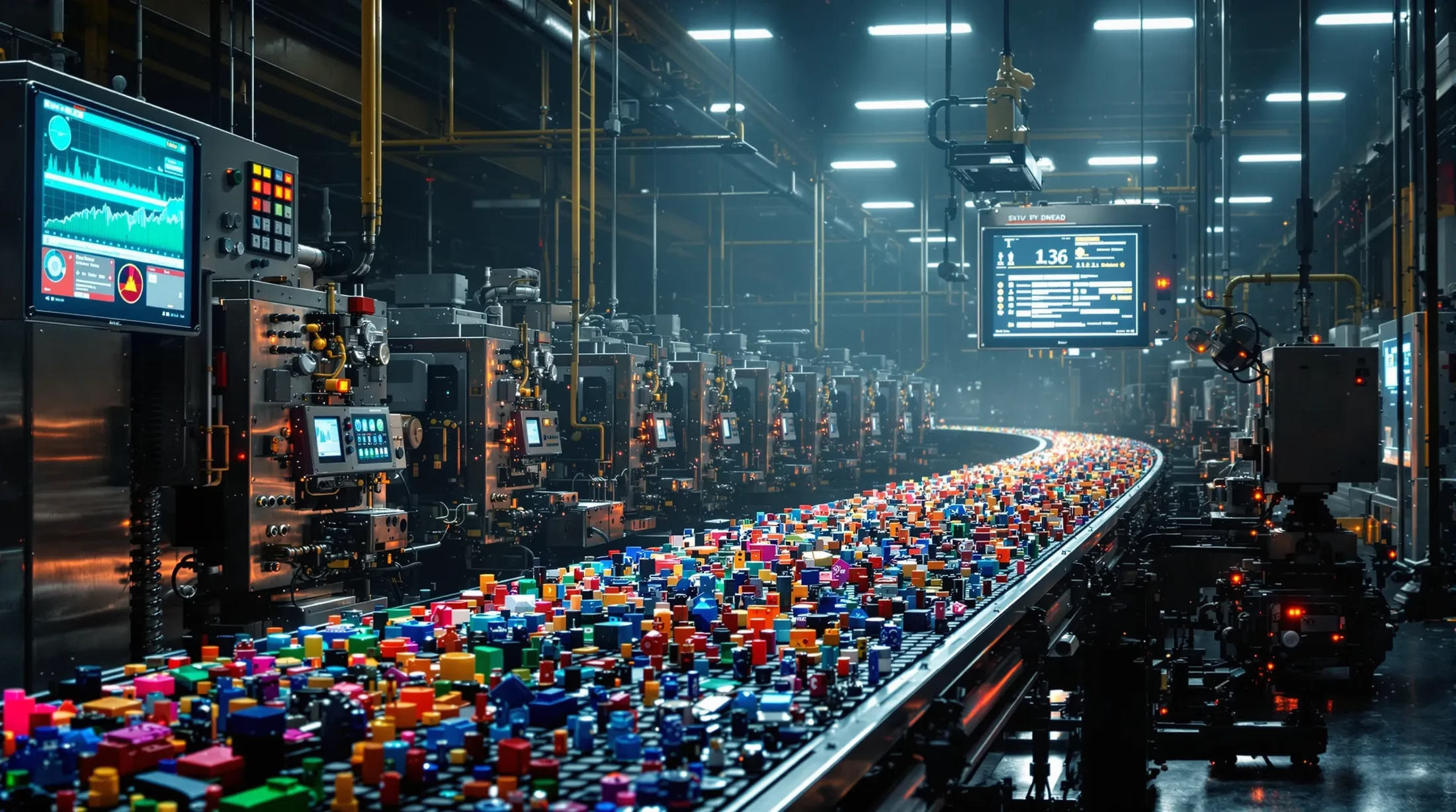Batch Production: Definition, Benefits, and Key Methods
Discover how batch production revolutionizes manufacturing efficiency while maintaining product quality and flexibility. This comprehensive guide explores the essential aspects of batch manufacturing and its impact across various industries.
What is Batch Production?
Batch production is a manufacturing method where products are created in groups or batches rather than in a continuous stream. In this process, a specific quantity of identical items is produced simultaneously, with each batch moving through the various production stages together. The manufacturer determines both the size of each batch and the frequency of production cycles based on demand, resource availability, and operational capacity.
A key characteristic of batch production is its sequential nature—a new batch cannot begin a particular production stage until the previous batch has completed that phase. This allows manufacturers to make adjustments between batches, modifying specifications like color, size, or design features to create different products using the same equipment and production lines.
Definition and Overview
At its core, batch production is defined by the creation of specified groups of identical products within a set time frame. Unlike continuous production, where items are manufactured in an uninterrupted flow, batch production divides manufacturing into discrete, manageable units of work. Each batch undergoes the same sequence of operations, from raw material processing to finishing touches, before the final product is completed.
This manufacturing approach offers significant flexibility, as equipment can be reconfigured between batches to accommodate different product specifications. The batch size is typically determined by factors such as:
- Customer orders and demand patterns
- Storage capacity limitations
- Equipment capabilities and constraints
- Shelf life of materials and finished products
- Production efficiency requirements
Industries Utilizing Batch Production
| Industry | Applications |
|---|---|
| Food and Beverage | Baked goods, dairy products, packaged meals, beverages |
| Pharmaceutical | Medications, medical supplies |
| Textile | Fabrics, garments, seasonal collections |
| Chemical | Precise formulations, controlled processing |
| Consumer Goods | Cosmetics, cleaning products, electronics |
Benefits of Batch Production
Batch production offers multiple strategic advantages for manufacturers across various industries. This production method enhances operational efficiency by creating multiple identical products simultaneously, which streamlines processes and substantially reduces production time.
Cost-Effectiveness and Flexibility
The economic advantages of batch production stem from its inherent flexibility and resource optimization. By producing in defined batches, manufacturers can significantly reduce setup times compared to constantly reconfiguring production lines for different items. This efficiency translates directly to cost savings, as labor and equipment resources are utilized more effectively across production runs.
Enhanced Quality Control
- Systematic inspection protocols at each production stage
- Early detection of defects and specification deviations
- Comprehensive traceability and documentation
- Quick isolation of affected batches if issues arise
- Regular equipment testing and calibration opportunities
Variety and Customization
Batch production excels in offering product variety and customization capabilities that surpass traditional manufacturing methods. The system allows manufacturers to implement design changes between batches, utilizing existing equipment and production lines to create multiple product variations. This adaptability enables businesses to develop diverse product portfolios targeting different market segments or seasonal demands without requiring substantial additional investment in manufacturing infrastructure.
The customization potential extends through several key areas:
- Product characteristics modification between batches
- Color, size, and material variations
- Feature customization for specific markets
- Regional preference accommodation
- Seasonal product adaptation
Challenges of Batch Production
Batch production presents several operational challenges that manufacturers must address effectively. The primary concern revolves around production efficiency, as setup changes between batches create significant downtime. Each transition requires equipment reconfiguration, machinery recalibration, and potential staff retraining, all contributing to non-productive periods in the manufacturing cycle.
| Challenge Area | Impact |
|---|---|
| Inventory Management | Balancing raw materials and finished goods storage with production schedules |
| Quality Control | Maintaining consistency across different batches |
| Demand Forecasting | Preventing overproduction or stockouts |
Automation and Downtime
The intersection of automation and downtime presents a significant challenge in batch production environments. While automation enhances efficiency during active production, the inherent nature of batch processes creates unavoidable idle periods during changeovers. These transitions demand equipment adjustments, cleaning procedures, and sometimes mechanical modifications that extend downtime, particularly in facilities with limited automation.
- Advanced automated systems can reduce setup times
- Programmable controls enable faster transitions
- Quick-change tooling minimizes downtime
- Staggered production schedules maximize equipment utilization
- Efficient changeover protocols optimize operations
Higher Costs Compared to Mass Production
Batch production typically incurs higher per-unit costs than mass production methods, primarily due to inherent process inefficiencies. These include extended setup times between batches, potential equipment underutilization, and lower production volumes. Unlike mass production, which distributes fixed costs across large quantities of identical items, batch production must absorb these expenses across smaller product runs.
Labor costs further contribute to the elevated expense structure, as workers require specialized skills to handle diverse product specifications and frequent changeovers. Despite these higher costs, manufacturers often accept this premium as a necessary trade-off for the flexibility and customization capabilities that batch production uniquely provides.
Key Methods in Batch Production
Batch production methodology encompasses various approaches that enable efficient production of defined product groups. These methods feature the capability to produce multiple products in single production runs, built-in flexibility for product type changes, and standardized processes for each batch. Manufacturers can modify their production lines between batches, achieving versatility without extensive retooling requirements.
Project Management Software for Efficiency
- Comprehensive planning and scheduling solutions
- Real-time production tracking capabilities
- Automated quality checkpoints integration
- Inventory management systems
- Production analytics and reporting tools
- Inter-departmental communication platforms
Advanced project management applications provide specialized features for batch manufacturing environments, enabling manufacturers to identify bottlenecks, optimize batch sizes, and adjust production schedules proactively. These solutions streamline communication between departments while providing visibility across the entire production cycle, resulting in reduced errors, minimized idle time, and enhanced overall productivity.
Production Scheduling and Resource Management
Effective production scheduling serves as the foundation of successful batch manufacturing operations, requiring precise coordination across multiple production runs. Modern scheduling systems employ sophisticated algorithms that optimize production sequences by considering:
- Equipment capabilities and limitations
- Setup and changeover times
- Material availability and logistics
- Delivery deadlines and commitments
- Workforce allocation and skills
Resource management in batch production environments focuses on strategic allocation of assets to maximize productivity while controlling costs. This encompasses implementing just-in-time inventory practices, developing cross-training programs, and establishing preventive maintenance schedules.
| Resource Area | Management Strategy |
|---|---|
| Physical Assets | Equipment optimization and maintenance scheduling |
| Human Resources | Cross-training and flexible workforce deployment |
| Inventory | Just-in-time practices and storage optimization |
| Production Capacity | Balanced workload distribution across product lines |
Comparing Batch Production with Other Methods
Batch production occupies a strategic middle ground in manufacturing methodologies, balancing efficiency with flexibility. Unlike continuous production’s uninterrupted flow or job shop production’s highly customized approach, batch manufacturing creates distinct groups of identical items that move through production stages together.
Batch Production vs. Mass Production
The fundamental distinction between batch and mass production lies in their operational philosophies. Mass production creates enormous quantities of standardized products through dedicated production lines, while batch production generates finite groups of products that can vary between batches.
- Mass production achieves lower per-unit costs through extreme specialization
- Batch production offers superior quality control and defect isolation
- Lower initial capital investment requirements for batch systems
- Greater market responsiveness through between-batch modifications
- Enhanced risk management in batch production environments
Batch Production vs. Continuous Production
Continuous production operates without interruption, creating a constant stream of identical products, while batch production generates defined groups with clear start and end points. This fundamental difference creates distinct operational characteristics:
| Aspect | Continuous Production | Batch Production |
|---|---|---|
| Operation Flow | Uninterrupted process | Defined production runs |
| Flexibility | Limited product variation | High adaptability |
| Quality Control | Continuous monitoring | Between-batch inspection |
| Cost Structure | Lowest per-unit costs | Moderate per-unit costs |







